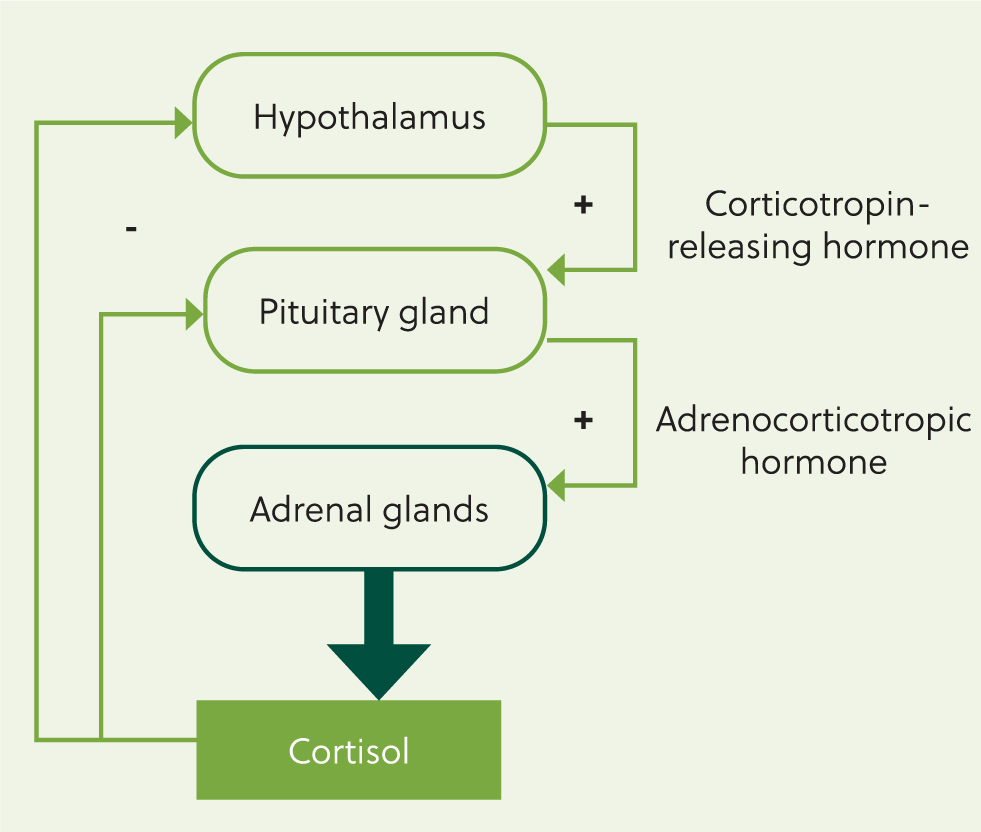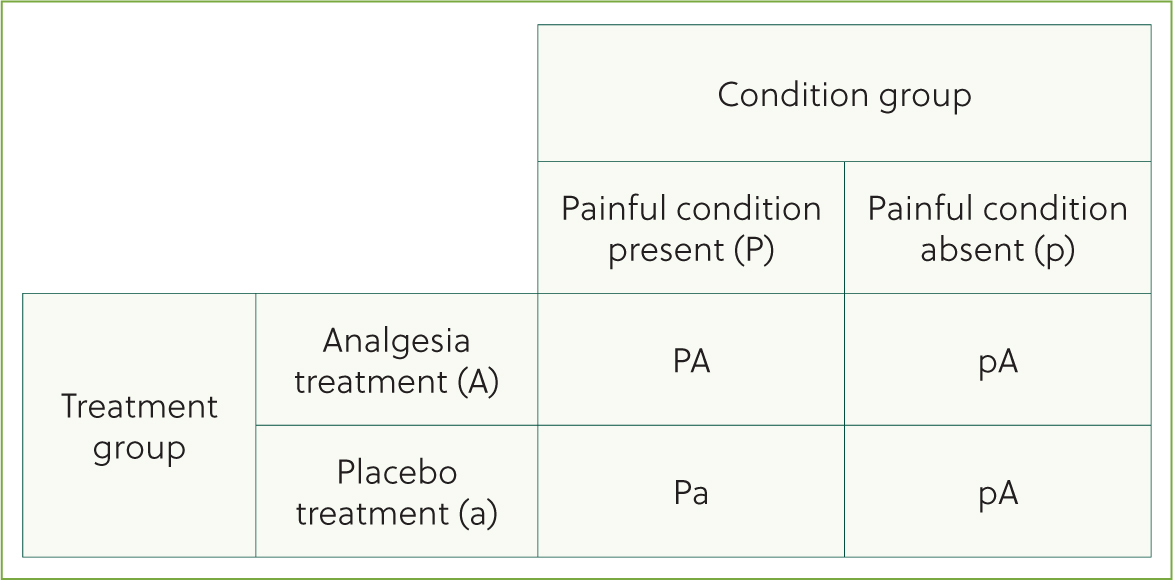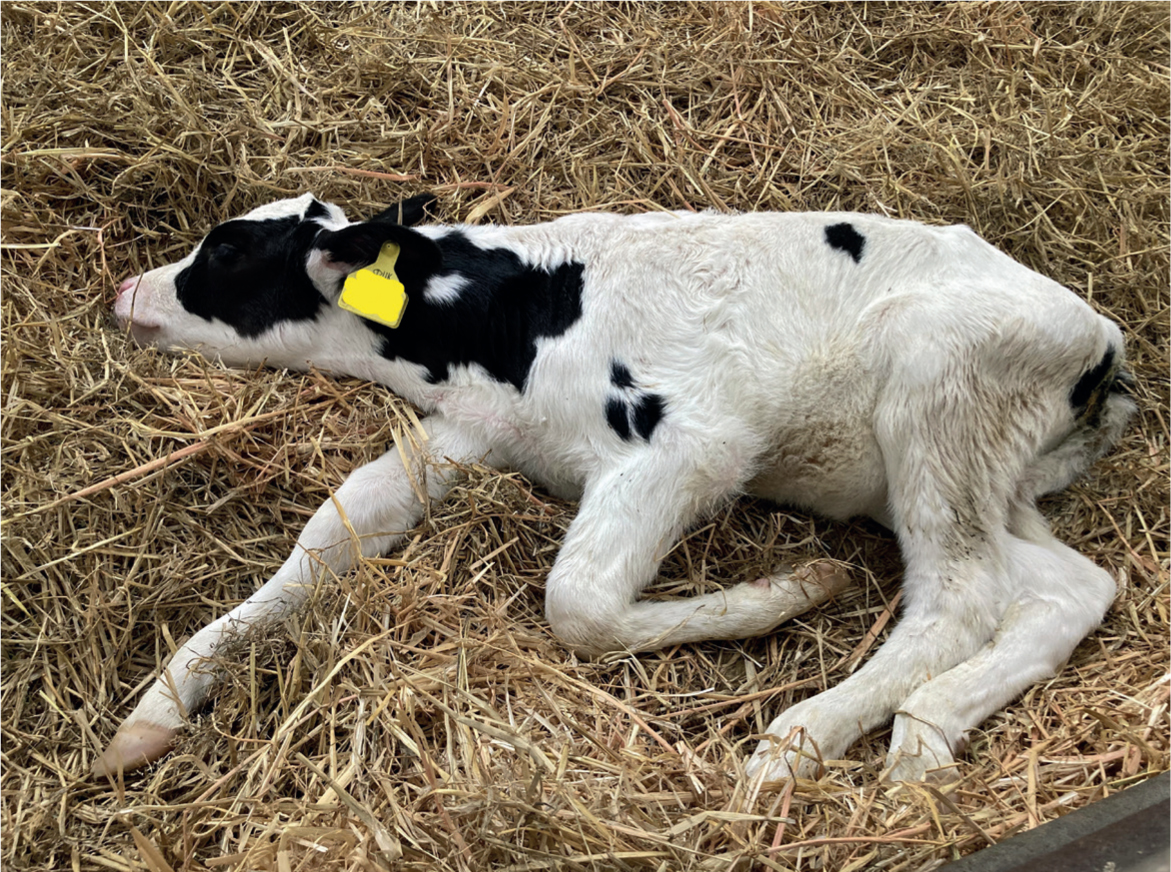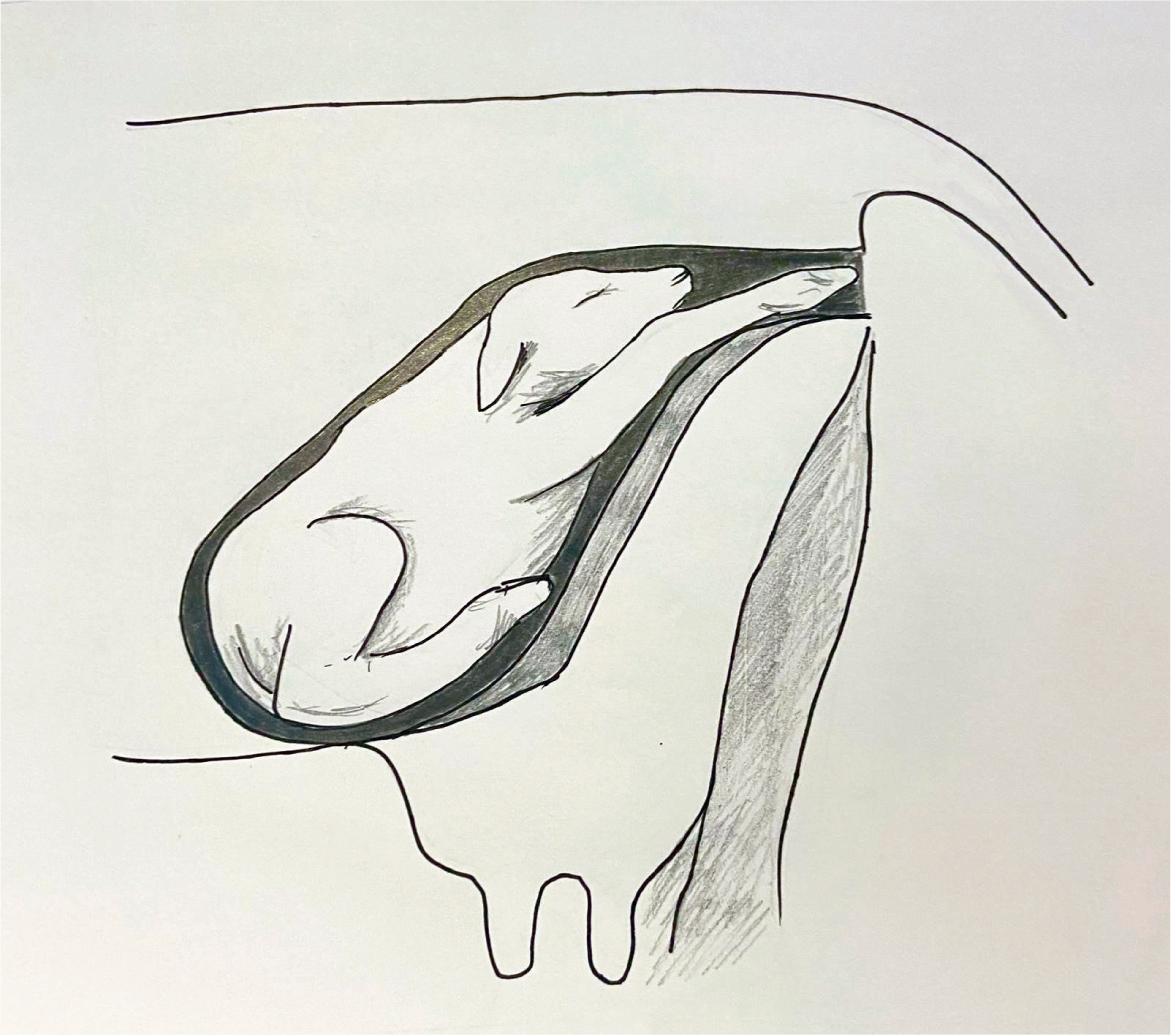Birth can be associated with adverse welfare outcomes in calves, particularly if management is suboptimal. The welfare of calves during birth is difficult to assess, and some authors argue that the unconscious state of calves in utero and during birth (before initiation of breathing) precludes suffering (Mellor and Gregory, 2003; Mellor and Diesche, 2006). Nevertheless, events occurring during birth (especially if assisted) are known to affect the welfare of calves in the immediate post-birth period; therefore, it is important that the calf 's welfare is considered during birth.
Effects of birth experience
The welfare of calves during the birth process has not been researched but a number of studies have investigated the welfare of newborn calves in the immediate post-birth period, often relating newborn welfare to birth experience. Ruminant parturition is initiated by an increase in fetal plasma cortisol concentration and it is normal for plasma cortisol concentration in calves to markedly increase immediately before birth, followed by a rapid decline in the first 24 hours of life (Liggins, 1968; Comline et al, 1974). However, physiological and emotional stress is also associated with increased cortisol concentration as a result of stimulation of adrenocorticotropic hormone production (Figure 1). Accordingly, an increase in cortisol concentration is considered to be indicative of stress and is commonly measured in studies as an indicator of a reduced state of welfare.

Studies investigating the effects of the birth experience consistently find that although cortisol concentration is predictably increased in all newborn calves, cortisol concentration in calves experiencing assisted birth or dystocia is higher than that in unassisted calves (Civelek et al, 2008; Barrier et al, 2013; Kovács et al, 2021), suggesting that assisted birth is associated with increased neonatal stress and reduced welfare of newborn calves. These findings are supported by studies of newborn calf behaviour that have found assisted calves engage in more behaviours associated with a poorer welfare state (such as abnormal lying postures), and fewer behaviours associated with positive welfare (such as play behaviour), than unassisted calves (Barrier et al, 2012; Gladden et al, 2019).
The reasons for these findings are not clear, but assisted birth can be associated with neonatal tissue trauma (even in the absence of clinically obvious injury) (Pearson et al, 2019a). As such, it is likely that pain (a negative affective state) contributes to the reduced welfare of assisted calves – a hypothesis supported by the results of studies that found analgesia-treated calves engaged in more behaviours consistent with positive welfare and fewer consistent with negative welfare than placebo-treated calves (Murray et al, 2016; Gladden et al, 2019; Kovács et al, 2022).
Use of analgesia
Calves in behavioural studies were treated with non-steroidal anti-inflammatory drug (NSAID) analgesia (Murray et al, 2016; Gladden et al, 2019; Kovács et al, 2022), a class of pain relief widely available for use in cattle. Collectively, the findings suggested that NSAID treatment immediately after birth has the potential to improve the welfare of newborn calves; however, in the UK no NSAIDs are licensed for newborn calves and, as such, use is off licence.
Although adverse effects of NSAIDs have not been studied in newborn calves, Pearson et al (2019b) did not identify any negative effects of meloxicam treatment on biochemical measures of renal or hepatic function, and ketoprofen treatment within 3 hours of birth has also not been found to have adverse effects (Gladden, 2021). It should be noted that these studies only recruited clinically healthy calves, so practitioners should adopt a risk-based approach when considering NSAID treatment of newborn calves, especially if calves are potentially compromised (e.g. as a result of acidosis).
Pain during and after birth
Infant humans experience substantial compressive pelvic forces during normal labour (Ami et al, 2019), but these forces have not been studied in calves. Although assisted calves can experience subclinical injury (Pearson et al, 2019a), it is unclear if neonatal pain (or subclinical injury) occurs following unassisted birth. While a 2 x 2 factorial study design (Figure 2) (where animals both experiencing and not experiencing a painful condition are randomly allocated to be treated with either analgesia or a placebo) is considered optimal for assessing animal pain (Weary et al, 2006), this design is rarely used in newborn calf studies. Just two studies investigating the effects of analgesia and calving assistance on newborn calf behaviour (a sensitive measure of welfare) have used this design (Gladden et al, 2019; Kovács et al, 2022).

Kovács et al (2022) did not identify any effects of interaction between analgesia treatment and birth assistance on newborn calf behaviours. Conversely, Gladden et al (2019) did identify interaction effects between analgesia and assistance status. These effects included analgesia-treated unassisted calves spending less time engaged in lateral recumbency (Figure 3), an uncommon lying posture more likely to be adopted by calves when in pain or unwell (Molony and Kent, 1997; Endres and Barberg, 2007; van Erpvan der Kooij et al, 2019)). This finding suggested that unassisted calves may experience pain after birth, and comfort is improved by NSAIDs. This result was supported by the finding that analgesia was associated with increased engagement in play behaviour (an indicator of positive welfare) regardless of birth assistance status, suggesting that all calves may experience birth-related pain (Gladden et al, 2019).

Interestingly, Kovács et al (2022) found that regardless of birth experience, analgesia-treated low-vitality calves (assessed using a modified Apgar (1953) score) engaged in behaviours consistent with improved welfare more than placebo-treated low vitality calves, but normal vitality calves were not affected by analgesia. This finding supports the hypothesis that unassisted calves may experience birth-related pain but also suggests that other factors are present that may contribute to pain experienced. Kovács et al (2022) did not investigate factors affecting calf vitality in their study and did not report if birth experience was associated with vitality; however, lactic acidosis in calves has been associated with poor newborn calf Apgar scores (i.e. poor vitality) (Sorge et al, 2009) and it is possible that neonatal acidosis affects the newborn calf 's experience of pain. This is an area that deserves further study.
Effects of acidosis
Mild acidosis at birth (blood pH 7.0–7.2) is normal for calves and is thought to aid adaptation to extrauterine life (Varga et al, 1998). More severe acidosis is associated with poorer calf health and increased mortality (Szenci et al, 1988; Schuijt and Taverne, 1994), and so it can compromise calf welfare. Birth difficulty is consistently associated with an abnormal degree of lactic acidosis in affected calves (Diesch et al, 2004; Sorge et al, 2009; Bleul and Götz, 2013; Homerosky et al, 2017a), and is another possible reason why assisted birth may be associated with reduced calf welfare. However, prolonged unassisted birth has also been associated with neonatal acidosis (Kovács et al, 2017); therefore, it cannot be assumed that a calf born without assistance will not be affected. This further supports the notion that suboptimal birth management more generally (in this case prolonged duration) can have adverse welfare effects for the neonate.
Effects of breeding
Breeding decisions can be used to minimise the risk of dystocia (e.g. by considering calving ease indices (Agriculture and Horticulture Development Board, 2023)) and accordingly contribute to improved newborn calf welfare. However, while aiming to prevent dystocia as far as possible is recommended, assisted birth is not completely avoidable (e.g. if the calf is malpresented). As such, careful application of birth assistance is important and can contribute to improved calf welfare. For instance, studies consistently find that the incidence of birth assistance exceeds that of dystocia (Mee et al, 2011; Holmøy et al, 2017), suggesting that calves are routinely experiencing birth assistance that may be unwarranted. This hypothesis is supported by studies suggesting that over a quarter of farmers routinely assist every calving (Villettaz Robichaud et al, 2016). If the calf is malpresented, assistance should be provided as soon as the malpresentation is identified (Schuenemann et al, 2011). However, in cases where the calf is normally presented (Figure 4), intervening both too early and too late have been shown to have deleterious effects (in particular stillbirth). The optimal approach is to conduct close observation for approximately 1 hour after appearance of fetal hooves before providing assistance if the calf has not been born in that time (Schuenemann et al, 2011; Villettaz Robichaud et al, 2017). Encouraging application of these guidelines can reduce the risk of injury and lead to improved welfare of newborn calves, as well as their dams.

Colostrum feeding
Colostrum provides the first extrauterine nutrition to calves after birth and its management is an important contributor to newborn calf welfare. The immunological importance of providing an adequate volume of good quality, clean colostrum to newborn calves in the first hours of life is well documented, and readers are referred to reviews in this publication and elsewhere for further detail (Weaver et al, 2000; Godden et al, 2019; Glover, 2021; Lorenz, 2021; Robbers et al, 2021). In addition to providing immunoglobulins, colostrum is also an important source of energy, macronutrients and micronutrients for newborn calves (Blum and Hammon, 2000; Osorio, 2020; Lopez and Heinrichs, 2022). Additionally, colostrum contains non-nutrient factors, such as insulin-like growth factors I and II (IGF-I and IGF-II) and growth hormone (Blum and Hammon, 2000; Hammon et al, 2013). Collectively, these characteristics of colostrum aid calf development and adaptation to extrauterine life (Ontsouka et al, 2016), and are particularly important to development of the calf 's gastrointestinal tract (Steinhoff-Wagner et al, 2014). The contribution adequate colostrum management to welfare is therefore not restricted to early life (or to immune status) but has a wider long-lasting impact on calf development.
Studies investigating colostrum consumption frequently focus on the immunological benefits of colostrum (i.e. passive transfer of immunoglobulins) and typically report a high prevalence of failure of passive transfer. For example, studies from New Zealand (Cuttance et al, 2017; Lawrence et al, 2017), the USA (Beam et al, 2009), the UK (Bragg et al, 2020; Denholm et al, 2022) and Canada (Waldner and Rosengren, 2009) report a prevalence of failure of passive transfer of 15–33%. Although these studies do not focus on the nutritional benefits of colostrum, the results suggest that globally, many calves are not receiving colostrum that has been adequately managed. This hypothesis is supported by a UK study that found colostrum management on most farms did not meet industry recommendations, with just 54% of farmers providing a known and appropriate volume of colostrum (Baxter-Smith and Simpson, 2020). These findings suggest that suboptimal colostrum management is common – an issue likely to be affecting newborn calf nutritional status as much as passive immunity – and has the potential to compromise the welfare of newborn calves worldwide.
Nutritional welfare and future health outcomes of newborn calves can be improved by ensuring that all calves receive a volume of colostrum at least 10–12% of their body weight (4–4.5 litres for the average Holstein calf) within the first 4 hours of life (Godden et al, 2019). Welfare is optimised if cow colostrum is fed, as calves that were fed colostrum replacer have been found to have reduced intestinal mucosal development and absorptive capacity compared to calves fed maternal colostrum (Steinhoff-Wagner et al, 2014). Nevertheless, passive transfer of immunoglobulins in calves that are fed good quality colostrum replacer is comparable to calves that are fed maternal colostrum (Lopez et al, 2020; Ahmadi et al, 2021), if enough IgG is provided (Godden et al, 2009a). Therefore, while not optimal, good quality colostrum replacers are an alternative for farmers if cow colostrum is unavailable.
To maximise welfare, calves should be fed using a teat wherever possible, as this most closely reflects natural behaviour and stimulates closure of the oesophageal groove, directing colostrum to the abomasum rather than via the forestomach (Lateur-Rowet and Breukink, 1983). Passive transfer is comparable between calves that are fed with a bottle or oesophageal feeder when appropriate volumes of colostrum are fed (Godden et al, 2009b); therefore, an oesophageal feeder has value for ensuring calves that do not suckle well consume enough colostrum. This is an important consideration as suckle reflex is a good indicator of the risk of failure of passive transfer (Homerosky et al, 2017b). The high proportion of calves that do not suckle adequately in the first 6 hours of life (Edwards and Broom, 1979) means that although allowing calves to suckle facilitates natural cow–calf interactions and may promote a positive welfare state, human intervention to ensure adequate colostrum consumption by calves is often needed to minimise the risk of failure of passive transfer.
Cow–calf separation
It is common for calves to be removed from cows within 24 hours of birth on commercial dairy farms (Medrano-Galarza et al, 2017), but this practice is under increasing public scrutiny and is frequently highlighted as an area of consumer concern (Busch et al, 2017; Beaver et al, 2019). Proposed (neonatal) benefits of separating calves from their dams soon after birth include reduced exposure to pathogens and improved health outcomes, as well as more reliable colostrum consumption. These suggested advantages of early cow–calf separation have the potential to contribute to positive newborn calf welfare through improved health, but supporting data are limited. A review found that few studies convincingly demonstrated an association between improved calf health and early cow–calf separation, concluding that improved neonatal health could not be used to support recommending early cow–calf separation (Beaver et al, 2019). Moreover, some studies have found that prolonged dam contact is associated with improved calf growth rate and health outcomes (Weary and Chua, 2000; Flower and Weary, 2001; Wagenaar and Langhout, 2007).
By contrast, there is more evidence to support the view that prolonged cow–calf contact has positive welfare benefits for calves from the perspective of behavioural interactions. For example, social interaction is increased in calves separated from their dams at 2 weeks of age compared to those separated within 24 hours of birth (Flower and Weary, 2001), and calves separated from cows at 4 days after birth engaged in social play more than calves separated at 1 day after birth (Stěhulová et al, 2008; Wagner et al, 2013). However, results are inconsistent and other studies have not identified a cow–calf separation effect on social play (Duve et al, 2012). Furthermore, most studies assess longer-term welfare effects of prolonged dam contact (Meagher et al, 2019), with the few studies that assess effects on the welfare of newborn calves typically finding that early separation (<1 day old) is associated with fewer behavioural indicators of neonatal distress compared to later separation (Weary and Chua, 2000). As such, based on existing studies, it is difficult to draw conclusions regarding the effects of early cow–calf separation on newborn calf welfare; although the available data suggest that if cow–calf separation is practised, early separation may be preferable.
Conclusions
This article provides an overview of some factors affecting the welfare of newborn calves. Although there are few studies of newborn calf welfare compared to studies of older calves and adult cows, the available data support the view that birth experience can have an adverse effect on newborn calf welfare and, as such, calving assistance should be managed with consideration of the calf (as well as the cow). It is probable that assisted calves – and possibly also unassisted calves – experience birth-related pain, and analgesia has the potential to improve the welfare of affected calves in the first hours and days of life. Appropriate colostrum feeding is important for the nutritional welfare of newborn calves as well as having an important role in the development of calf immunity; however, it is widely reported that colostrum management is suboptimal, and this is an area where there is the potential for significant welfare gains. By contrast, the welfare effects of cow–calf separation on newborn calves are still not well established, although some research suggests that extended contact with dams may be beneficial for welfare, an area that warrants further research.
KEY POINTS
- The welfare of newborn calves can be negatively affected by suboptimal calving practices, including inappropriate assistance.
- Careful and appropriate application of calving assistance can improve newborn calf welfare. When birth assistance is provided, analgesia with non-steroidal anti-inflammatory drugs has the potential to contribute to improved welfare in the first few days of life.
- Colostrum management should be optimised to ensure the nutritional welfare of newborn calves, as well as passive transfer of immunity, but available data indicate that on many farms there are still improvements to be made.
- Effects of cow–calf separation on newborn calf welfare is currently unclear and more research in this area is warranted.

